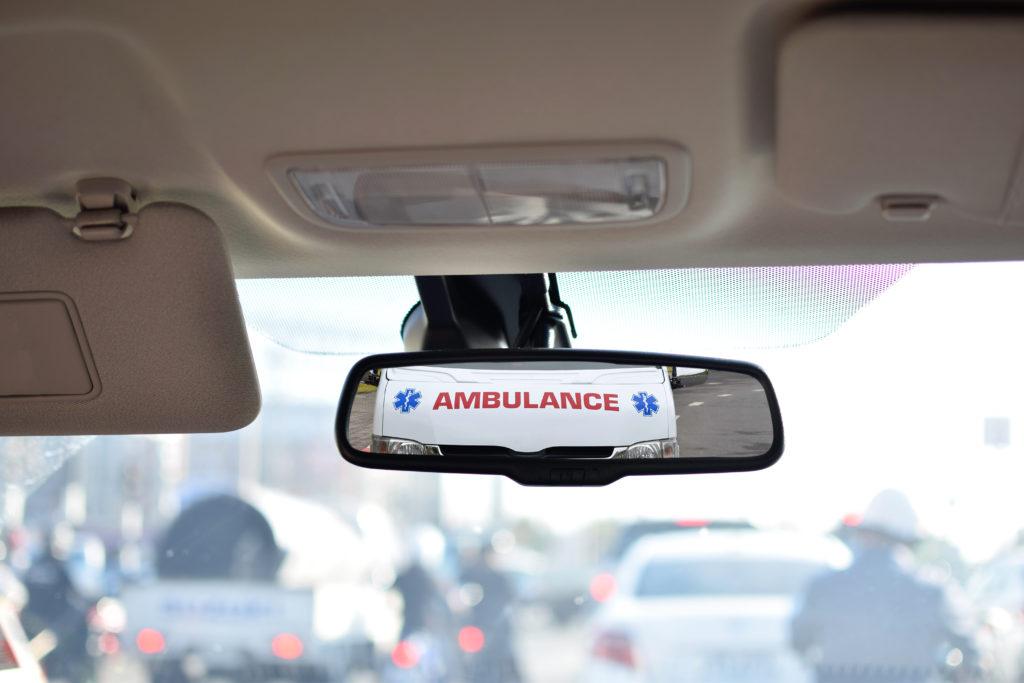This post may contain affiliate links, which means we’ll receive a commission if you purchase through our link, at no extra cost to you. Please read full disclosure here.
This post is your step-by-step guide to what to do when an ambulance is behind you.

Imagine you’re driving down the road, enjoying your day.
Suddenly, you hear the blaring siren and catch a glimpse of flashing lights in your rearview mirror. An ambulance is behind you, racing to save someone’s life.
In this critical moment, knowing how to respond can make all the difference.
In this step-by-step guide, we’ll walk you through what to do when an ambulance is behind you, ensuring you can safely assist emergency vehicles and help save lives.
What To Do When An Ambulance Is Coming
Step 1: Be Aware
Let’s be real — it’s impossible to do the right thing when an ambulance is coming if you never hear it coming in the first place.
For this reason, it’s crucial to be aware while you drive, at all times.
Being aware requires eliminating distractions in whatever form they come.
However, when it comes to reacting to an oncoming ambulance you specifically want to avoid wearing headphones or cranking up the music when driving.
Keeping the volume at a reasonable level allows you to hear sirens and horns more easily, giving you more time to react.
We understand, blasting your favorite tunes on a long drive can be fun, but keeping a keen ear out for emergency signals can literally save lives.
Step 2: Stay Calm and Focused
Before you do anything else, it’s important to stay calm and composed.
There’s no need to panic!
By remaining focused and calm, you can ensure that you make the right decisions in this crucial situation.
Step 3: Determine Your Next Best Move
Next, you want to assess the traffic situation around you and determine the safest course of action.
This is a must.
You never want to rush and move without thinking as this can cause accidents of its own.
Here’s how to clear the way for the ambulance without jeopardizing the safety of yourself or others on the road:
- First, check your rearview and side mirrors for any approaching emergency vehicle. The further away it is, the more time you have to react. (Sometimes, the sirens may be coming from an ambulance heading in the opposite direction and you may not need to do anything at all.)
- Next, look out for any pedestrians, potential hazards, or obstacles on the road immediately around you.
- Then decide whether it’s best to safely pull over to the side of the road, change lanes, stop, or slow down to create a clear path for the emergency vehicle.

Step 4: Signal and Pull Over Safely
Once you know what you’re going to do, use your indicators/turn signal to show your intention to pull over.
Then gradually and safely move your vehicle to the right side of the road (or the left if you drive on the left), creating a clear path for the ambulance.
Remember to use your turn signals, check your blind spots, and take into account other vehicles around you before moving.
Related: 67 Countries That Drive On The Left (+ The Dramatic Reason They Do)
Step 5: Resume Driving
Once the ambulance has passed, wait for a safe opportunity, merge back into traffic, and continue on your way.
Remember to remain cautious and aware of your surroundings, as other emergency vehicles or situations may arise (and you get to do it all over. — Yay!)
By following these steps, you can assist emergency vehicles in reaching their destination promptly and safely.
Your cooperation can help save precious lives in critical moments.
What To Do When An Emergency Vehicle Approaches
It’s not only ambulances that can appear behind you requiring your urgent but careful response. Firetrucks, police cars, and other emergency vehicles may also need to quickly pass by.
Luckily, the steps are the same regardless of the type of emergency vehicle so you can use these guidelines whenever you hear a siren or see lights flashing in your rearview mirror.
So again, here’s what to do when any emergency vehicle approaches:
- Be Aware
- Stay Calm and Focused
- Determine Your Next Best Move
- Signal and Pull Over Safely
- Resume Driving
Understanding the Wake Effect
If you’ve never heard this about the wake effect before you’re not alone.
It’s not something that gets talked about often but it’s super important to understand so you can avoid it at all costs.
The term “wake effect” comes from the concept of a wake left behind a swiftly moving object, like a boat skimming through water.
In the context of emergency vehicles, it refers to the disruptions in traffic flow that occur as a result of drivers pulling over to let these vehicles pass.
These disturbances can potentially result in “wake effect collisions”.
What is the best definition for the wake effect collision?
It’s where vehicles moving back into the flow of traffic after yielding for an ambulance, for example, collide with other vehicles, usually because they aren’t paying enough attention.
Thankfully, there’s a simple way to avoid such complications.
The key is to remember not to rush back into traffic once the emergency vehicle has passed. Stay focused, be patient, use your indicators, and only merge back when it’s absolutely safe to do so.
Conclusion
Knowing how to respond when an ambulance approaches is essential for every driver.
By staying calm, determining the best course of action, and then signaling and pulling over safely, you can assist emergency vehicles and contribute to a safer road environment.
Share this guide with others to promote awareness and ensure that everyone knows what to do when an ambulance is behind them.
Let’s all play our part in saving lives on the road!